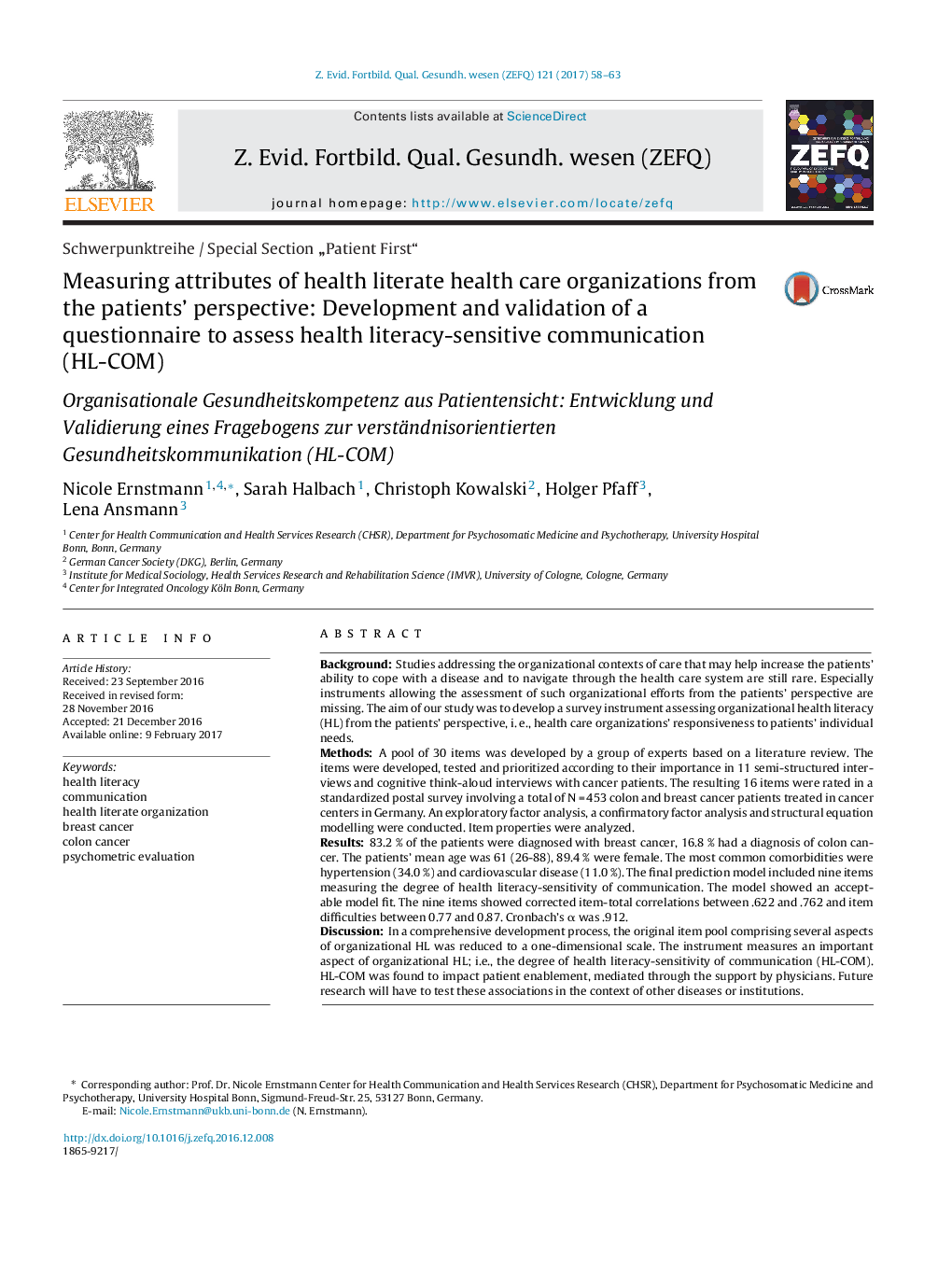| کد مقاله | کد نشریه | سال انتشار | مقاله انگلیسی | نسخه تمام متن |
|---|---|---|---|---|
| 5123520 | 1487300 | 2017 | 6 صفحه PDF | دانلود رایگان |

BackgroundStudies addressing the organizational contexts of care that may help increase the patients' ability to cope with a disease and to navigate through the health care system are still rare. Especially instruments allowing the assessment of such organizational efforts from the patients' perspective are missing. The aim of our study was to develop a survey instrument assessing organizational health literacy (HL) from the patients' perspective, i. e., health care organizations' responsiveness to patients' individual needs.MethodsA pool of 30 items was developed by a group of experts based on a literature review. The items were developed, tested and prioritized according to their importance in 11 semi-structured interviews and cognitive think-aloud interviews with cancer patients. The resulting 16 items were rated in a standardized postal survey involving a total of N = 453 colon and breast cancer patients treated in cancer centers in Germany. An exploratory factor analysis, a confirmatory factor analysis and structural equation modelling were conducted. Item properties were analyzed.Results83.2 % of the patients were diagnosed with breast cancer, 16.8 % had a diagnosis of colon cancer. The patients' mean age was 61 (26-88), 89.4 % were female. The most common comorbidities were hypertension (34.0 %) and cardiovascular disease (11.0 %). The final prediction model included nine items measuring the degree of health literacy-sensitivity of communication. The model showed an acceptable model fit. The nine items showed corrected item-total correlations between .622 and .762 and item difficulties between 0.77 and 0.87. Cronbach's α was .912.DiscussionIn a comprehensive development process, the original item pool comprising several aspects of organizational HL was reduced to a one-dimensional scale. The instrument measures an important aspect of organizational HL; i.e., the degree of health literacy-sensitivity of communication (HL-COM). HL-COM was found to impact patient enablement, mediated through the support by physicians. Future research will have to test these associations in the context of other diseases or institutions.
ZusammenfassungHintergrundOrganisationsbezogene Strategien, die die individuellen Gesundheitskompetenzen von Krankenhauspatienten berücksichtigen oder stärken, werden bislang wenig systematisch untersucht. Es mangelt insbesondere an spezifischen Instrumenten, die es erlauben, diese Aktivitäten im Sinne einer Organisationsdiagnostik aus Patientensicht zu messen. Das Ziel der vorliegenden Studie ist es daher, einen Fragebogen zur Bewertung der organisationalen Gesundheitskompetenz von Krankenhäusern zu entwickeln.MethodeEs wurde ein Pool von 30 Items entwickelt. Diese wurden in einem iterativen Prozess in 11 kognitiven Interviews mit Krebspatienten priorisiert, getestet und überarbeitet. Die finalen 16 Items wurden zur psychometrischen Testung und Validierung in einer standardisierten Patientenbefragung eingesetzt. Befragt wurden N = 453 Darm- und Brustkrebspatienten aus zertifizierten Organkrebszentren. Die Daten wurden mittels exploratorischer und konfirmatorischer Faktorenanalyse, Strukturgleichungsmodellierung und Reliabilitätsanalyse ausgewertet.Ergebnisse83 % der eingeschlossenen Patienten litten an Brustkrebs, 17 % an Darmkrebs. Das mittlere Alter lag bei 61 Jahren (Min. 26, Max. 88). 89 % der Patienten waren Frauen. Die häufigste Begleiterkrankung war mit 34 % die Hypertonie, gefolgt von kardiovaskulären Erkrankungen (11 %). Das finale Strukturgleichungsmodell enthielt 9 Items, die den Faktor âverständnisorientierte Gesundheitskommunikation“ abbilden. Die Modellpassung zeigte akzeptable Werte. Die Trennschärfe der Items lag bei Werten zwischen .622 und .762. Die Analyse der Itemschwierigkeit ergab Werte zwischen 0,77 und 0,87. Die Prüfung der internen Konsistenz ergab ein Cronbach's α von .912.DiskussionDer Itempool wurde in einem umfassenden Fragebogenentwicklungs- und Validierungsprozess zu einer eindimensionalen Skala reduziert. Die finale Skala misst lediglich einen zentralen Aspekt der organisationalen Gesundheitskompetenz: die verständnisorientierte Gesundheitskommunikation. Diese hängt in Verbindung mit der Unterstützung durch die behandelnden Ãrzte stark mit der Befähigung von Krebspatienten zum Umgang mit ihrer Erkrankung zusammen. Dieser Zusammenhang sollte zukünftig in anderen Settings überprüft werden.
Journal: Zeitschrift für Evidenz, Fortbildung und Qualität im Gesundheitswesen - Volume 121, April 2017, Pages 58-63